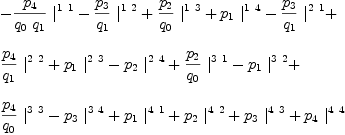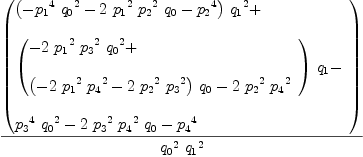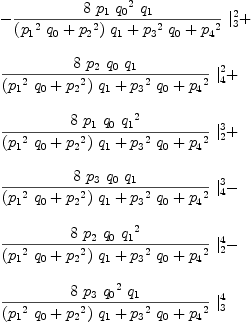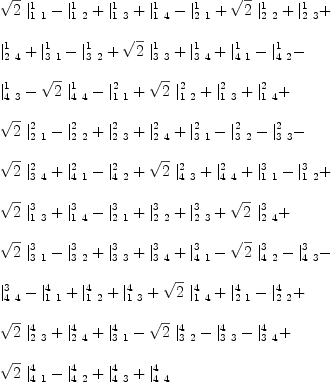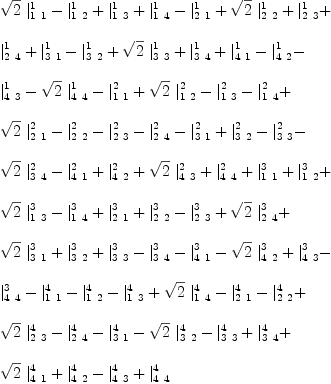Quaternion Algebra Is Frobenius In Many Ways
Linear operators over a 4-dimensional vector space representing quaternion algebra
Ref:
We need the Axiom LinearOperator? library.
axiom
)library MONAL PROP LIN CALEY
Monoidal is now explicitly exposed in frame initial
Monoidal will be automatically loaded when needed from
/var/zope2/var/LatexWiki/MONAL.NRLIB/MONAL
Prop is now explicitly exposed in frame initial
Prop will be automatically loaded when needed from
/var/zope2/var/LatexWiki/PROP.NRLIB/PROP
LinearOperator is now explicitly exposed in frame initial
LinearOperator will be automatically loaded when needed from
/var/zope2/var/LatexWiki/LIN.NRLIB/LIN
CaleyDickson is now explicitly exposed in frame initial
CaleyDickson will be automatically loaded when needed from
/var/zope2/var/LatexWiki/CALEY.NRLIB/CALEY
Use the following macros for convenient notation
axiom
-- summation
macro Σ(x)==reduce(+,x)
Type: Void
axiom
macro ΣΞ(x,i)==reduce(+,[x for i in 1..dim])
Type: Void
axiom
-- list
macro Ξ(f,i)==[f for i in 1..dim]
Type: Void
𝐋 is the domain of 4-dimensional linear operators over the domain of rational functions ℚ (Expression Integer), i.e. ratio of polynomials with integer coefficients.
axiom
dim:=4
axiom
macro ℒ == List
Type: Void
axiom
macro ℂ == CaleyDickson
Type: Void
axiom
macro ℚ == Expression Integer
Type: Void
axiom
𝐋 := LinearOperator(dim, OVAR [], ℚ)
Type: Type
axiom
𝐞:ℒ 𝐋 := basisVectors()
Type: List(LinearOperator
?(4,
OrderedVariableList
?([]),
Expression(Integer)))
axiom
𝐝:ℒ 𝐋 := basisForms()
Type: List(LinearOperator
?(4,
OrderedVariableList
?([]),
Expression(Integer)))
axiom
o:𝐋:=1 -- identity for product
Type: LinearOperator
?(4,
OrderedVariableList
?([]),
Expression(Integer))
axiom
I:𝐋:=[1] -- identity for composition
Type: LinearOperator
?(4,
OrderedVariableList
?([]),
Expression(Integer))
axiom
X:𝐋:=[2,1] -- twist
Type: LinearOperator
?(4,
OrderedVariableList
?([]),
Expression(Integer))
Now generate structure constants for Quaternion Algebra
The basis consists of the real and imaginary units. We use quaternion multiplication to form the "multiplication table" as a matrix. Then the structure constants can be obtained by dividing each matrix entry by the list of basis vectors.
axiom
-- Also split-complex via Caley-Dickson parameter (p0 = -1)
q0:=subscript('q,[0])
Type: Symbol
axiom
q1:=subscript('q,[1])
Type: Symbol
axiom
QQ := ℂ(ℂ(ℚ,'i,q0),'j,q1)
![\label{eq10}\hbox{\axiomType{CaleyDickson<a class=
\label{eq10}\hbox{\axiomType{CaleyDickson}\ } (\hbox{\axiomType{CaleyDickson}\ } (\hbox{\axiomType{Expression}\ } (\hbox{\axiomType{Integer}\ }) , i , <em> 01 q (0)) , j , </em> 01 q (1))]() ?}\ } (\hbox{\axiomType{CaleyDickson?}\ } (\hbox{\axiomType{Expression}\ } (\hbox{\axiomType{Integer}\ }) , i , 01 q (0)) , j , 01 q (1))" class="equation" src="images/8228930438219976963-16.0px.png" align="bottom" Style="vertical-align:text-bottom" width="551" height="18"/> ?}\ } (\hbox{\axiomType{CaleyDickson?}\ } (\hbox{\axiomType{Expression}\ } (\hbox{\axiomType{Integer}\ }) , i , 01 q (0)) , j , 01 q (1))" class="equation" src="images/8228930438219976963-16.0px.png" align="bottom" Style="vertical-align:text-bottom" width="551" height="18"/> | (10) |
Type: Type
axiom
-- Basis: Each B.i is a quaternion number
B:ℒ QQ := map(x +-> hyper x,1$SQMATRIX(dim,ℚ)::ℒ ℒ ℚ)
Type: List(CaleyDickson
?(CaleyDickson
?(Expression(Integer),
i,
*01q(0)),
j,
*01q(1)))
axiom
-- Multiplication table:
M:Matrix QQ := matrix Ξ(Ξ(B.i*B.j,i),j)
Type: Matrix(CaleyDickson
?(CaleyDickson
?(Expression(Integer),
i,
*01q(0)),
j,
*01q(1)))
axiom
-- Function to divide the matrix entries by a basis element
S(y) == map(x +-> real real(x/y),M)
Type: Void
axiom
-- The result is a nested list
ѕ :=map(S,B)::ℒ ℒ ℒ ℚ
axiom
Compiling function S with type CaleyDickson(CaleyDickson(Expression(
Integer),i,*01q(0)),j,*01q(1)) -> Matrix(Expression(Integer))Type: List(List(List(Expression(Integer))))
axiom
-- structure constants form a tensor operator
Y := ΣΞ(ΣΞ(ΣΞ(ѕ(i)(k)(j)*𝐞.i*𝐝.j*𝐝.k,i),j),k)
Type: LinearOperator
?(4,
OrderedVariableList
?([]),
Expression(Integer))
axiom
arity Y
Type: Prop
axiom
matrix Ξ(Ξ((𝐞.i*𝐞.j)/Y,i),j)
Type: Matrix(LinearOperator
?(4,
OrderedVariableList
?([]),
Expression(Integer)))
A scalar product is denoted by the (2,0)-tensor

axiom
U:=inp([inp([script(u,[[j,i],[]]) for i in 1..dim])$𝐋 for j in 1..dim])$𝐋
Type: LinearOperator
?(4,
OrderedVariableList
?([]),
Expression(Integer))
Definition 1
We say that the scalar product is associative if the tensor
equation holds:
Y = Y
U U
In other words, if the (3,0)-tensor:
(three-point function) is zero.
Using the LinearOperator? domain in Axiom and some carefully chosen symbols we can easily enter expressions that are both readable and interpreted by Axiom as "graphical calculus" diagrams describing complex products and compositions of linear operators.
axiom
ω:𝐋 :=
o Y I /
o U -
o I Y /
o U o
Type: LinearOperator
?(4,
OrderedVariableList
?([]),
Expression(Integer))
Note: The only purpose of the o symbols on the left above is to serve as a constant left-side margin as required by Axiom. The symbols on the right describe the relation between row.
Definition 2
An algebra with a non-degenerate associative scalar product
is called a [Frobenius Algebra]?.
We may consider the problem where multiplication Y is given,
and look for all associative scalar products 
This problem can be solved using linear algebra.
axiom
)expose MCALCFN
MultiVariableCalculusFunctions is now explicitly exposed in frame
initial
J := jacobian(ravel ω,concat map(variables,ravel U)::ℒ Symbol);
Type: Matrix(Expression(Integer))
axiom
u := transpose matrix [concat map(variables,ravel U)::ℒ Symbol];
Type: Matrix(Polynomial(Integer))
axiom
J::OutputForm * u::OutputForm = 0
Type: Equation(OutputForm
?)
axiom
nrows(J),ncols(J)
Type: Tuple(PositiveInteger
?)
The matrix J transforms the coefficients of the tensor  into coefficients of the tensor
into coefficients of the tensor  . We are looking for
the general linear family of tensors
. We are looking for
the general linear family of tensors  such that
such that
J transforms  into
into  for any such
for any such  .
.
If the null space of the J matrix is not empty we can use
the basis to find all non-trivial solutions for U:
axiom
Ñ:=nullSpace(J)
Type: List(Vector(Expression(Integer)))
axiom
ℰ:=map((x,y)+->x=y,concat map(variables,ravel U),
entries Σ[p[i]*Ñ.i for i in 1..#Ñ])
Type: List(Equation(Expression(Integer)))
axiom
Ų := map(x+->subst(x,ℰ),U)$𝐋
Type: LinearOperator
?(4,
OrderedVariableList
?([]),
Expression(Integer))
This defines a family of pre-Frobenius algebras:
axiom
test(map(x+->subst(x,ℰ),ω)$𝐋=0*ω)
Type: Boolean
The scalar product must be non-degenerate:
axiom
Ů:=determinant [[retract((𝐞.i * 𝐞.j)/Ų) for j in 1..dim] for i in 1..dim]
Type: Expression(Integer)
axiom
factor Ů
Type: Factored(Expression(Integer))
Definition 3
Co-pairing
axiom
Ω:𝐋:=unravel((0/2)$Prop,concat(transpose(1/Ů*adjoint([[retract((𝐞.i * 𝐞.j)/Ų)
for j in 1..dim] for i in 1..dim]).adjMat)::ℒ ℒ ℚ))
Type: LinearOperator
?(4,
OrderedVariableList
?([]),
Expression(Integer))
Check dimension
axiom
d:𝐋:=
o Ω /
o Ų o
Type: LinearOperator
?(4,
OrderedVariableList
?([]),
Expression(Integer))
Definition 4
Co-algebra:
λ:𝐋 :=
o Ω Ω I /
o I Y I I /
o I X I /
o I I Ų o
--test
Why aren't these the same?? Left and Right co-algebras because quaternions are not commutative?
axiom
λ:𝐋 :=
o I Ω /
o Y I o
Type: LinearOperator
?(4,
OrderedVariableList
?([]),
Expression(Integer))
axiom
λr:𝐋 :=
o Ω I /
o I Y o
Type: LinearOperator
?(4,
OrderedVariableList
?([]),
Expression(Integer))
axiom
λ - λr
Type: LinearOperator
?(4,
OrderedVariableList
?([]),
Expression(Integer))
i = Unit of the algebra
axiom
i:=𝐞.1
Type: LinearOperator
?(4,
OrderedVariableList
?([]),
Expression(Integer))
axiom
test
o i /
o λ = Ω
Type: Boolean
axiom
test
o i /
o λr = Ω
Type: Boolean
Handle(s)
axiom
Hl:𝐋 :=
o λ o /
o Y o
Type: LinearOperator
?(4,
OrderedVariableList
?([]),
Expression(Integer))
axiom
Hr:𝐋 :=
o λr o /
o Y o
Type: LinearOperator
?(4,
OrderedVariableList
?([]),
Expression(Integer))
axiom
Hl - Hr
Type: LinearOperator
?(4,
OrderedVariableList
?([]),
Expression(Integer))
Definition 5
Co-unit
i
U
axiom
ι:𝐋:=
o i I /
o Ų o
Type: LinearOperator
?(4,
OrderedVariableList
?([]),
Expression(Integer))
Y=U
ι
axiom
test
o Y /
o ι o = Ų
Type: Boolean
For example:
axiom
Ų0:=map(x+->subst(x,[q[0]=-1,q[1]=-1,p[1]=1,p[2]=1,p[3]=1,p[4]=-sqrt(2)]),Ų)$𝐋
Type: LinearOperator
?(4,
OrderedVariableList
?([]),
Expression(Integer))
axiom
Ω0:=map(x+->subst(x,[q[0]=-1,q[1]=-1,p[1]=1,p[2]=1,p[3]=1,p[4]=-sqrt(2)]),Ω)$𝐋
Type: LinearOperator
?(4,
OrderedVariableList
?([]),
Expression(Integer))
axiom
λ0:=map(x+->subst(x,[q[0]=-1,q[1]=-1,p[1]=1,p[2]=1,p[3]=1,p[4]=-sqrt(2)]),λ)$𝐋
Type: LinearOperator
?(4,
OrderedVariableList
?([]),
Expression(Integer))
axiom
λr0:=map(x+->subst(x,[q[0]=-1,q[1]=-1,p[1]=1,p[2]=1,p[3]=1,p[4]=-sqrt(2)]),λr)$𝐋
Type: LinearOperator
?(4,
OrderedVariableList
?([]),
Expression(Integer))
axiom
Hl0:=map(x+->subst(x,[q[0]=-1,q[1]=-1,p[1]=1,p[2]=1,p[3]=1,p[4]=-sqrt(2)]),Hl)$𝐋
Type: LinearOperator
?(4,
OrderedVariableList
?([]),
Expression(Integer))
axiom
Hr0:=map(x+->subst(x,[q[0]=-1,q[1]=-1,p[1]=1,p[2]=1,p[3]=1,p[4]=-sqrt(2)]),Hr)$𝐋
Type: LinearOperator
?(4,
OrderedVariableList
?([]),
Expression(Integer))
 -permuted Frobenius Algebras
-permuted Frobenius Algebras

![\label{eq13}\begin{array}{@{}l}
\displaystyle
\left[{\left[{\left[ 1, \: 0, \: 0, \: 0 \right]}, \:{\left[ 0, \: -{q_{0}}, \: 0, \: 0 \right]}, \:{\left[ 0, \: 0, \: -{q_{1}}, \: 0 \right]}, \:{\left[ 0, \: 0, \: 0, \: -{{q_{0}}\ {q_{1}}}\right]}\right]}, \: \right.
\
\
\displaystyle
\left.{\left[{\left[ 0, \: 1, \: 0, \: 0 \right]}, \:{\left[ 1, \: 0, \: 0, \: 0 \right]}, \:{\left[ 0, \: 0, \: 0, \: -{q_{1}}\right]}, \:{\left[ 0, \: 0, \:{q_{1}}, \: 0 \right]}\right]}, \: \right.
\
\
\displaystyle
\left.{\left[{\left[ 0, \: 0, \: 1, \: 0 \right]}, \:{\left[ 0, \: 0, \: 0, \:{q_{0}}\right]}, \:{\left[ 1, \: 0, \: 0, \: 0 \right]}, \:{\left[ 0, \: -{q_{0}}, \: 0, \: 0 \right]}\right]}, \: \right.
\
\
\displaystyle
\left.{\left[{\left[ 0, \: 0, \: 0, \: 1 \right]}, \:{\left[ 0, \: 0, \: - 1, \: 0 \right]}, \:{\left[ 0, \: 1, \: 0, \: 0 \right]}, \:{\left[ 1, \: 0, \: 0, \: 0 \right]}\right]}\right]
\label{eq13}\begin{array}{@{}l}
\displaystyle
\left[{\left[{\left[ 1, \: 0, \: 0, \: 0 \right]}, \:{\left[ 0, \: -{q_{0}}, \: 0, \: 0 \right]}, \:{\left[ 0, \: 0, \: -{q_{1}}, \: 0 \right]}, \:{\left[ 0, \: 0, \: 0, \: -{{q_{0}}\ {q_{1}}}\right]}\right]}, \: \right.
\
\
\displaystyle
\left.{\left[{\left[ 0, \: 1, \: 0, \: 0 \right]}, \:{\left[ 1, \: 0, \: 0, \: 0 \right]}, \:{\left[ 0, \: 0, \: 0, \: -{q_{1}}\right]}, \:{\left[ 0, \: 0, \:{q_{1}}, \: 0 \right]}\right]}, \: \right.
\
\
\displaystyle
\left.{\left[{\left[ 0, \: 0, \: 1, \: 0 \right]}, \:{\left[ 0, \: 0, \: 0, \:{q_{0}}\right]}, \:{\left[ 1, \: 0, \: 0, \: 0 \right]}, \:{\left[ 0, \: -{q_{0}}, \: 0, \: 0 \right]}\right]}, \: \right.
\
\
\displaystyle
\left.{\left[{\left[ 0, \: 0, \: 0, \: 1 \right]}, \:{\left[ 0, \: 0, \: - 1, \: 0 \right]}, \:{\left[ 0, \: 1, \: 0, \: 0 \right]}, \:{\left[ 1, \: 0, \: 0, \: 0 \right]}\right]}\right]](images/7724765806973633822-16.0px.png)


![]()
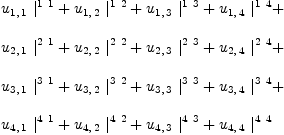
(2.2,0.1)(2.6,0.1)(2.6,0.9)
\psline[linewidth=0.04cm](2.4,0.3)(2.4,-0.1)
\psbezier[linewidth=0.04](2.4,-0.1)(2.4,-0.9)(3.0,-0.9)(3.0,-0.1)
\psline[linewidth=0.04cm](3.0,-0.1)(3.0,0.9)
\psbezier[linewidth=0.04](4.8,0.9)(4.8,0.1)(4.4,0.1)(4.4,0.9)
\psline[linewidth=0.04cm](4.6,0.3)(4.6,-0.1)
\psbezier[linewidth=0.04](4.6,-0.1)(4.6,-0.9)(4.0,-0.9)(4.0,-0.1)
\psline[linewidth=0.04cm](4.0,-0.1)(4.0,0.9)
\usefont{T1}{ptm}{m}{n}
\rput(3.4948437,0.205){-}
\psline[linewidth=0.04cm](0.6,-0.7)(0.6,0.9)
\psbezier[linewidth=0.04](0.0,-0.1)(0.0,-0.9)(1.2,-0.9)(1.2,-0.1)
\psline[linewidth=0.04cm](0.0,-0.1)(0.0,0.9)
\psline[linewidth=0.04cm](1.2,-0.1)(1.2,0.9)
\usefont{T1}{ptm}{m}{n}
\rput(1.6948438,0.205){=}
\end{pspicture}
}
\scalebox{1} % Change this value to rescale the drawing.
{
\begin{pspicture}(0,-0.92)(4.82,0.92)
\psbezier[linewidth=0.04](2.2,0.9)(2.2,0.1)(2.6,0.1)(2.6,0.9)
\psline[linewidth=0.04cm](2.4,0.3)(2.4,-0.1)
\psbezier[linewidth=0.04](2.4,-0.1)(2.4,-0.9)(3.0,-0.9)(3.0,-0.1)
\psline[linewidth=0.04cm](3.0,-0.1)(3.0,0.9)
\psbezier[linewidth=0.04](4.8,0.9)(4.8,0.1)(4.4,0.1)(4.4,0.9)
\psline[linewidth=0.04cm](4.6,0.3)(4.6,-0.1)
\psbezier[linewidth=0.04](4.6,-0.1)(4.6,-0.9)(4.0,-0.9)(4.0,-0.1)
\psline[linewidth=0.04cm](4.0,-0.1)(4.0,0.9)
\usefont{T1}{ptm}{m}{n}
\rput(3.4948437,0.205){-}
\psline[linewidth=0.04cm](0.6,-0.7)(0.6,0.9)
\psbezier[linewidth=0.04](0.0,-0.1)(0.0,-0.9)(1.2,-0.9)(1.2,-0.1)
\psline[linewidth=0.04cm](0.0,-0.1)(0.0,0.9)
\psline[linewidth=0.04cm](1.2,-0.1)(1.2,0.9)
\usefont{T1}{ptm}{m}{n}
\rput(1.6948438,0.205){=}
\end{pspicture}
}](images/2375189246716000159-16.0px.png)
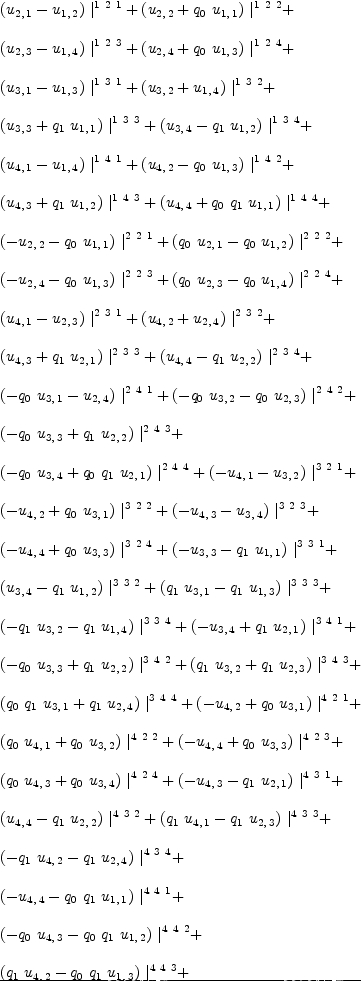
![]()
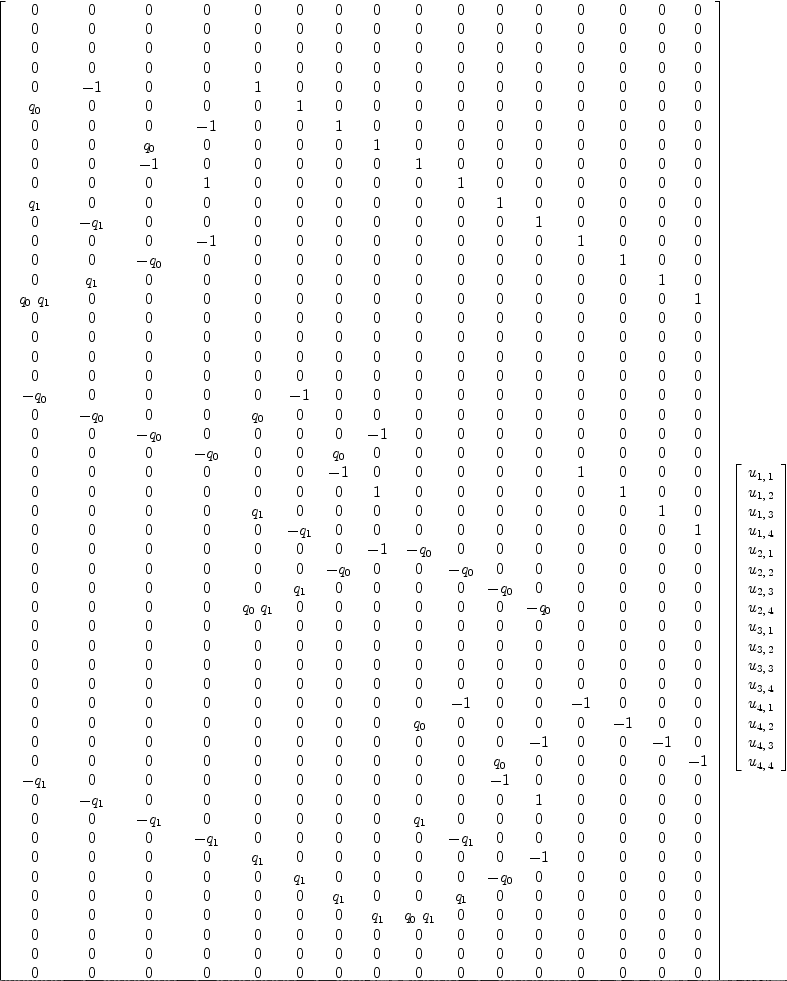
![]() into coefficients of the tensor
into coefficients of the tensor ![]() . We are looking for
the general linear family of tensors
. We are looking for
the general linear family of tensors ![]() such that
such that
![]() into
into ![]() for any such
for any such ![]() .
.![\label{eq22}\begin{array}{@{}l}
\displaystyle
\left[{\left[ 0, \: 0, \: 0, \: 1, \: 0, \: 0, \: 1, \: 0, \: 0, \: - 1, \: 0, \: 0, \: 1, \: 0, \: 0, \: 0 \right]}, \: \right.
\
\
\displaystyle
\left.{\left[ 0, \: 0, \:{1 \over{q_{0}}}, \: 0, \: 0, \: 0, \: 0, \: - 1, \:{1 \over{q_{0}}}, \: 0, \: 0, \: 0, \: 0, \: 1, \: 0, \: 0 \right]}, \: \right.
\
\
\displaystyle
\left.{\left[ 0, \: -{1 \over{q_{1}}}, \: 0, \: 0, \: -{1 \over{q_{1}}}, \: 0, \: 0, \: 0, \: 0, \: 0, \: 0, \: - 1, \: 0, \: 0, \: 1, \: 0 \right]}, \: \right.
\
\
\displaystyle
\left.{\left[ -{1 \over{{q_{0}}\ {q_{1}}}}, \: 0, \: 0, \: 0, \: 0, \:{1 \over{q_{1}}}, \: 0, \: 0, \: 0, \: 0, \:{1 \over{q_{0}}}, \: 0, \: 0, \: 0, \: 0, \: 1 \right]}\right]
\label{eq22}\begin{array}{@{}l}
\displaystyle
\left[{\left[ 0, \: 0, \: 0, \: 1, \: 0, \: 0, \: 1, \: 0, \: 0, \: - 1, \: 0, \: 0, \: 1, \: 0, \: 0, \: 0 \right]}, \: \right.
\
\
\displaystyle
\left.{\left[ 0, \: 0, \:{1 \over{q_{0}}}, \: 0, \: 0, \: 0, \: 0, \: - 1, \:{1 \over{q_{0}}}, \: 0, \: 0, \: 0, \: 0, \: 1, \: 0, \: 0 \right]}, \: \right.
\
\
\displaystyle
\left.{\left[ 0, \: -{1 \over{q_{1}}}, \: 0, \: 0, \: -{1 \over{q_{1}}}, \: 0, \: 0, \: 0, \: 0, \: 0, \: 0, \: - 1, \: 0, \: 0, \: 1, \: 0 \right]}, \: \right.
\
\
\displaystyle
\left.{\left[ -{1 \over{{q_{0}}\ {q_{1}}}}, \: 0, \: 0, \: 0, \: 0, \:{1 \over{q_{1}}}, \: 0, \: 0, \: 0, \: 0, \:{1 \over{q_{0}}}, \: 0, \: 0, \: 0, \: 0, \: 1 \right]}\right]](images/3264152696336064402-16.0px.png)
![\label{eq23}\begin{array}{@{}l}
\displaystyle
\left[{{u_{1, \: 1}}= -{{p_{4}}\over{{q_{0}}\ {q_{1}}}}}, \:{{u_{1, \: 2}}= -{{p_{3}}\over{q_{1}}}}, \:{{u_{1, \: 3}}={{p_{2}}\over{q_{0}}}}, \:{{u_{1, \: 4}}={p_{1}}}, \: \right.
\
\
\displaystyle
\left.{{u_{2, \: 1}}= -{{p_{3}}\over{q_{1}}}}, \:{{u_{2, \: 2}}={{p_{4}}\over{q_{1}}}}, \:{{u_{2, \: 3}}={p_{1}}}, \:{{u_{2, \: 4}}= -{p_{2}}}, \: \right.
\
\
\displaystyle
\left.{{u_{3, \: 1}}={{p_{2}}\over{q_{0}}}}, \:{{u_{3, \: 2}}= -{p_{1}}}, \:{{u_{3, \: 3}}={{p_{4}}\over{q_{0}}}}, \:{{u_{3, \: 4}}= -{p_{3}}}, \: \right.
\
\
\displaystyle
\left.{{u_{4, \: 1}}={p_{1}}}, \:{{u_{4, \: 2}}={p_{2}}}, \:{{u_{4, \: 3}}={p_{3}}}, \:{{u_{4, \: 4}}={p_{4}}}\right]
\label{eq23}\begin{array}{@{}l}
\displaystyle
\left[{{u_{1, \: 1}}= -{{p_{4}}\over{{q_{0}}\ {q_{1}}}}}, \:{{u_{1, \: 2}}= -{{p_{3}}\over{q_{1}}}}, \:{{u_{1, \: 3}}={{p_{2}}\over{q_{0}}}}, \:{{u_{1, \: 4}}={p_{1}}}, \: \right.
\
\
\displaystyle
\left.{{u_{2, \: 1}}= -{{p_{3}}\over{q_{1}}}}, \:{{u_{2, \: 2}}={{p_{4}}\over{q_{1}}}}, \:{{u_{2, \: 3}}={p_{1}}}, \:{{u_{2, \: 4}}= -{p_{2}}}, \: \right.
\
\
\displaystyle
\left.{{u_{3, \: 1}}={{p_{2}}\over{q_{0}}}}, \:{{u_{3, \: 2}}= -{p_{1}}}, \:{{u_{3, \: 3}}={{p_{4}}\over{q_{0}}}}, \:{{u_{3, \: 4}}= -{p_{3}}}, \: \right.
\
\
\displaystyle
\left.{{u_{4, \: 1}}={p_{1}}}, \:{{u_{4, \: 2}}={p_{2}}}, \:{{u_{4, \: 3}}={p_{3}}}, \:{{u_{4, \: 4}}={p_{4}}}\right]](images/4324324814581690651-16.0px.png)
